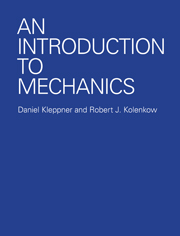Book contents
- Frontmatter
- Contents
- LIST OF EXAMPLES
- PREFACE
- TO THE TEACHER
- AN INTRODUCTION TO MECHANICS
- 1 VECTORS AND VECTORS KINEMATICS—A FEW MATHEMATICAL PRELIMINARIES
- 2 NEWTON'S LAWS—THE FOUNDATIONS OF NEWTONIAN MECHANICS
- 3 MOMENTUM
- 4 WORK AND ENERGY
- 5 SOME MATHEMATICAL ASPECTS OF FORCE AND ENERGY
- 6 ANGULAR MOMENTUM AND FIXED AXIS ROTATION
- 7 RIGID BODY MOTION AND THE CONSERVATION OF ANGULAR MOMENTUM
- 8 NONINERTIAL SYSTEMS AND FICTITIOUS FORCES
- 9 CENTRAL FORCE MOTION
- 10 THE HARMONIC OSCILLATOR
- 11 THE SPECIAL THEORY OF RELATIVITY
- 12 RELATIVISTIC KINEMATICS
- 13 RELATIVISTIC MOMENTUM AND ENERGY
- 14 FOUR VECTORS AND RELATIVISTIC INVARIANCE
- INDEX
11 - THE SPECIAL THEORY OF RELATIVITY
- Frontmatter
- Contents
- LIST OF EXAMPLES
- PREFACE
- TO THE TEACHER
- AN INTRODUCTION TO MECHANICS
- 1 VECTORS AND VECTORS KINEMATICS—A FEW MATHEMATICAL PRELIMINARIES
- 2 NEWTON'S LAWS—THE FOUNDATIONS OF NEWTONIAN MECHANICS
- 3 MOMENTUM
- 4 WORK AND ENERGY
- 5 SOME MATHEMATICAL ASPECTS OF FORCE AND ENERGY
- 6 ANGULAR MOMENTUM AND FIXED AXIS ROTATION
- 7 RIGID BODY MOTION AND THE CONSERVATION OF ANGULAR MOMENTUM
- 8 NONINERTIAL SYSTEMS AND FICTITIOUS FORCES
- 9 CENTRAL FORCE MOTION
- 10 THE HARMONIC OSCILLATOR
- 11 THE SPECIAL THEORY OF RELATIVITY
- 12 RELATIVISTIC KINEMATICS
- 13 RELATIVISTIC MOMENTUM AND ENERGY
- 14 FOUR VECTORS AND RELATIVISTIC INVARIANCE
- INDEX
Summary
The Need for a New Mode of Thought
In some ways the structure of physics resembles a mansion whose outward form is apparent to the casual visitor but whose inner life—the customs and rituals which give a special outlook and kinship to its occupants—require time and effort to comprehend. Indeed, initiation into this special knowledge is the goal of our present endeavor. In the first ten chapters we introduced and applied the fundamental laws of classical mechanics; hopefully you now feel familiar with these laws and have come to appreciate their beauty, their essential simplicity, and their power.
Unfortunately, in order to present dynamics in a concise and tidy form, we have generally sidestepped discussion of how physics actually grew. In Chaps. 11 through 14 we are going to discuss one of the great achievements of modern physics, the special theory of relativity. Rather than present the theory as a completed structure—a simple set of postulates with the rules for their application—we shall depart from our previous style and look into the background of the theory and its rationale.
If the structure of physics is a mansion, it is a mansion of ancient origin. It is founded on the remains of prehistoric hovels where man first kept track of the moon and tried to understand the simple patterns of nature. Traces of antiquity lie hidden in the site: Phoenician and Egyptian, Babylonian, and, of course, Greek.
Information
- Type
- Chapter
- Information
- An Introduction to Mechanics , pp. 441 - 460Publisher: Cambridge University PressPrint publication year: 2010
